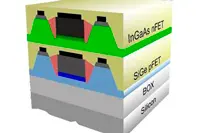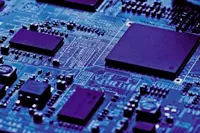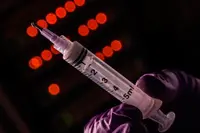Electronics News
Archive : 14 April 2016 год
 MC10, a US based healthcare technology company, has joined with design and manufacturing specialist PCH to commercialise the former’s Wearable Interactive Stamp Platform (WiSP).
MC10, a US based healthcare technology company, has joined with design and manufacturing specialist PCH to commercialise the former’s Wearable Interactive Stamp Platform (WiSP).
WISP, which is worn on the skin, is a stretchable and disposable stamp which is said to be just 0.05mm thick. When paired with a smartphone, tablet or NFC reader, WiSP is said to enable a variety of applications, such as cashless payments, hotel room access and event registration. WiSP can also be used in clinical environments to transmit patient information and to streamline procedures.
“We are excited to partner with PCH to expand the reach of MC10’s body worn electronics globally, within and beyond our core healthcare market,” said Scott Pomerantz, MC10’s president and CEO. “PCH’s experience working with leading consumer brands and its ability to commercialise the technology, will accelerate development of new applications skin worn wearables.”
PCH will work with third parties to customise the technology and to develop new applications for the technology, which was first commercialised in conjunction with L’Oréal as a way of measuring UV exposure.
To maintain the security of stored information, the breathable and waterproof stamp will tear and become unreadable upon removal.
Author
Graham Pitcher
Source: www.newelectronics.co.uk
 French research institute Leti has extended its collaboration with Qualcomm Technologies under which the partners were developing CoolCube, the former’s sequential integration technology.
French research institute Leti has extended its collaboration with Qualcomm Technologies under which the partners were developing CoolCube, the former’s sequential integration technology.
Created by Leti as a way of creating high density, high performance circuits, CoolCube is said to eliminate the need for through silicon vias – TSVs – to allow stacking of layers of active transistors.
“The Qualcomm and Leti teams have demonstrated the potential of this technology for designing and fabricating high density and high performance chips for mobile devices,” said Karim Arabi, Qualcomm Technologies’ vice president of engineering. “We are optimistic that this technology could address some of the technology scaling issues and this is why we are extending our collaboration with Leti.”
By introducing a stacking process that supports low temperature transistor processing, CoolCube technology avoids degrading the performance of transistors lower in the stack or the metal interconnects between the layers of the transistors.
As part of the renewed collaboration, the partners are looking to build a complete CoolCube ecosystem that takes the technology from design to fabrication.
Leti’s CEO Marie Semeria added: “Together, we aim to build a complete ecosystem, with foundries, equipment suppliers and EDA and design houses, to assemble all the pieces of the puzzle and move the technology into the product qualification phase.”
Author
Graham Pitcher
Source: www.newelectronics.co.uk
 A report from market analyst IHS says demand for seniconductors fell in 2015 and could herald three years of weak growth. Sequential quarterly growth was weak throughout every quarter of 2015, especially in the first quarter, when the market declined 8.9% over the previous quarter. That drop represented the deepest sequential quarterly decline since the market collapsed in the fourth quarter of 2008 and first quarter of 2009.
A report from market analyst IHS says demand for seniconductors fell in 2015 and could herald three years of weak growth. Sequential quarterly growth was weak throughout every quarter of 2015, especially in the first quarter, when the market declined 8.9% over the previous quarter. That drop represented the deepest sequential quarterly decline since the market collapsed in the fourth quarter of 2008 and first quarter of 2009.
Global revenue in 2015 was $347.3billion, down from $354.3bn in 2014, and was a significant slowdown on the solid growth of 8.3% in 2014 and 6.4% in 2013. That slowdown appears to have been borne out by the latest sales figures from the European Semiconductor Industry Association. According to the association, sales of semiconductors were flat in February this year when compared to January, while global demand dipped by 3.2% compared to the previous month, at $26bn.
“Weak results last year signal the beginning of what is expected to be a three-year period of declining to stagnant growth for semiconductor revenues,” said Dale Ford, vice president and chief analyst at IHS Technology. According to Ford, weak end market demand in major segments, including wireless communications, data processing and consumer electronics, will hold back semiconductor growth.
The IHS Semiconductors Service is predicting that compound annual growth in semiconductor revenues in the five years to 2020 will be 2.1%. However it expects that, based on current technology, economic, market and product trends, that sometime between 2020 and 2022 the development of new products will drive a significant level of growth in semiconductor revenues.
Looking back on 2015,Ford highlighted the record level of merger and acquisition activity as the ‘big story’ of the year. Top players pursued a number of bold, strategic moves, suggested Ford, ‘to enhance their market position and improve overall revenue growth and profitability’.
Intel retained its number one ranking in 2015, after completing its acquisition of Altera, which allowed the company to offset declining processor revenues and achieve 2.9% overall growth in 2015.
Among significant movers were Qualcomm, which fell to number four after revenues fell 14.5%, despite the 2015 acquisition of CSR, which proved to be not enough to counter declining revenues in the company’s key wireless markets. The final major deal among the top 10 in 2015 was NXP’s acquisition of Freescale, which lifted it to seventh position from 15th in 2014.
According to the report, whereas 2014 was a year of broad-based growth, the market downturn last year left few markets unscathed – revenues for data processing, wired communications and consumer electronics all declined. Automotive and industrial electronics grew by less than 1%, while the strongest market – wireless communications – only managed to grow by 3%.
Semiconductor revenues in all regions of the world declined, and all seven major semiconductor segments (memory, microcomponents, logic ICs, analogue ICs, discrete components, optical components and sensors) experienced revenue declines from 2014 to 2015.
Only 10 semiconductor market sub-segments with annual revenues of more than $1bn grew by more than 5% year over year in 2015. Wireless communications ASICs and analogue ASICs both grew by 30%, while RF small signal transistors, wired communications logic ASICs and wireless communication ASSPs grew between 10% and 20%.
Author
Neil Tyler
Source: www.newelectronics.co.uk
 A combined electrolyte and separator for rechargeable lithium-ion batteries developed at Rice University in the US supplies energy at usable voltages and in high temperatures. An essential part of the non flammable, toothpaste-like composite is hexagonal boron nitride (h-BN), also known as ‘white graphene’.
A combined electrolyte and separator for rechargeable lithium-ion batteries developed at Rice University in the US supplies energy at usable voltages and in high temperatures. An essential part of the non flammable, toothpaste-like composite is hexagonal boron nitride (h-BN), also known as ‘white graphene’.
The team, led by materials scientist Pulickel Ajayan, said batteries made with the composite functioned ‘perfectly’ in temperatures of 150°Cfor more than a month with negligible loss of efficiency. Test batteries operated consistently from room temperature to 150°C – one of the widest temperature ranges reported for such devices, the researchers said.
Researcher Marco-Túlio Rodrigues said: “We tested our composite against benchmark electrodes and found that the batteries were stable for more than 600 cycles of charge and discharge at high temperatures.”
Rodrigues added that batteries with the new electrolyte are more likely to be used in industrial and aerospace applications than in mobile phones. “[Oil and gas companies] put a lot of sensors around drill bits, which experience extreme temperatures,” he said. “It’s a real challenge to power these devices when they are thousands of feet downhole.”
Because h-BN is not a conductor and is not known to be an ionic conductor, the researchers didn’t expect it to assist battery performance. “But we thought a material that is chemically and mechanically resistant, even at very high temperatures, might give some stability to the electrolyte layer,” Rodrigues noted.
Lead researcher Ajayan concluded. “Pushing the boundaries of working temperature ranges is very interesting. There is no commercial battery product that works above about 80°C. Our interest is to break this barrier and create stable batteries at twice this temperature limit or more.”
Pic: Pic: Jeff Fitlow/Rice University
Author
Graham Pitcher
Source: www.newelectronics.co.uk

